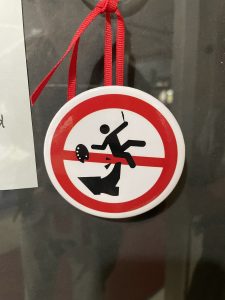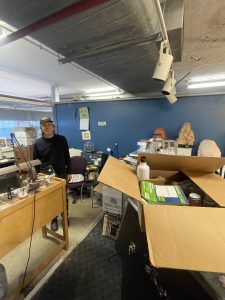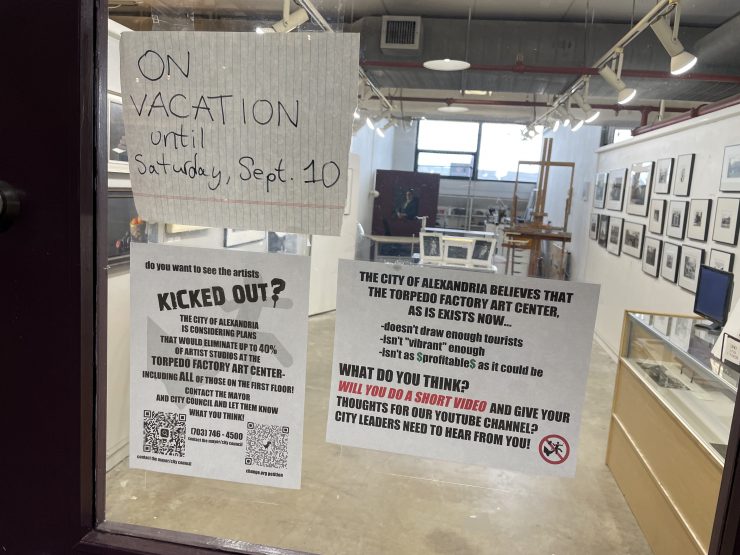Artists are protesting a new re-jurying process that aims to revitalize and modernize Alexandria’s Torpedo Factory.
Artists protest a plan to revitalize Alexandria’s Torpedo Factory Art Center, saying the city’s new re-jurying process drives out long-established art center studio members.
The City of Alexandria implemented the “Action Plan for Vibrancy & Sustainability” at the Torpedo Factory to examine an artist’s marketability, personality, background, and understanding of current artistic trends. The jury granted 26 out of 78 applicants a studio in 2022, leading artists to question the application process’s fairness, transparency, and ease.
“I felt ambushed and betrayed. I’ve been here since ’77, and I was good enough until now. All of a sudden, I’m not good enough anymore,” re-juried Torpedo Factory Artist Gerda Atzl said.
However, American University art professor Jack Rasmussen, a 2022 Torpedo Factory juror, said, “Yes, artists are, in a sense, being kicked out. Some of these artists have been there 30 years. So, they wanted to re-evaluate what was in the Torpedo Factory because, otherwise, it’s this never changing thing.”

Alexandria took control of all Torpedo Factory operations in 2018. Since then, artists say they have felt betrayed, saddened, and hurt by Alexandria’s new Action Plan for Vibrancy & Sustainability. The plan took effect on Dec. 14, 2021. The plan is intended to re-assess and circulate new artists into Torpedo Factory studios to attract people and revenue to aid in the center’s popularity and upkeep.
“The Vibrancy Plan will re-establish the art center’s identity for a 21st Century audience,” according to the 2022 Open Call Jury Report. The Vibrancy plan will re-assess and terminate artist contracts and replace them with artists Alexandria finds “more agreeable,” according to the Vibrancy Initiative.
The Vibrancy Initiative aimed to revitalize the building with a focus on public ease of access, establishing the waterfront entrance as the main entrance, and offering more “hands-on” opportunities. The interactive approach would allow the Torpedo Factory to provide more public services and increase interest in art and culture, according to the initiative.
The initiative will increase fundraising opportunities to support the community and explore alternative outreach methods. Alternative methods include modified hours to meet visitor needs, lessen artist fatigue, and provide more private studio time.
Torpedo Factory Director Brett John Johnson declined to comment but provided written information detailing how the center qualified artists for a studio. The process is divided into three phases, based on a 100-point system.
Phase one, worth 50 points, had jurors determine craftsmanship and originality and if the artist “reflects awareness of current trends and aesthetics in the larger art world.” Phase two, worth 25 points, had jurors judge whether artists could explain their artistic process and engage with an audience. The artists need to market themselves and their work in person and through a social media presence. In phase three, worth 25 points, jurors looked at the art’s quality and vetted how artists communicated and behaved with the public.
Artists are separated into three groups. Group A artists who obtained a studio between 1975 and 2003 and are subject to rejury now, group B artists who obtained a studio from 2004 to 2017 will not re-jury until 2023, and group C artists who acquired a studio from 2018 to 2021 will not be juried until 2024.
Artists said they also felt abused during the pandemic when the Art Center closed. “They closed for two years. I paid rent throughout those two years with nothing really coming in. Then, when I came back and situated, I was re-juried and told I could no longer keep the studio. It’s an injury to insult. My work is good,” jewelry artist Marcos Teixeira said.

“A board of artists for artists, then, the city began removing board members and placing city-appointed members who started making changes,” Texieria said.
Alexandria has owned the Torpedo Factory since 1969. The city managed the art center for 22 years. Afterwards, the city used third parties to operate the facility, including the Torpedo Factory Artists Association, a group of artists who ran its operations.
“The jury here does not work with the artists. They work against them. There is no longer a sense of community within the Torpedo Factory,” Torpedo Factory Artist M. Alexander Gray said. Gray acquired his studio in 2014 and will not re-jury until next year.
The Torpedo Factory near King Street is a gathering place and art gallery for local artists willing to sell their work to the public. The Factory began as a munition storage facility built at the end of World War I in 1918. It functioned as a construction plant for Mark II and III torpedoes and a munitions storage for 32 years before being converted to an art center in 1974.
Additional Sources:
https://torpedofactory.org/about-us/history/
https://torpedofactory.org/vibrancy/
TFAC-Action-Plan-for-Vibrancy-and-Sustainability-Final.pdf (torpedofactory.org)















Add comment